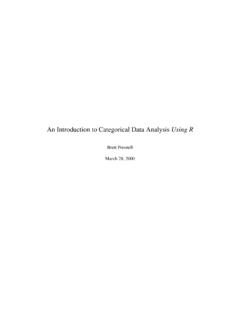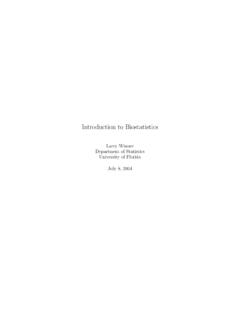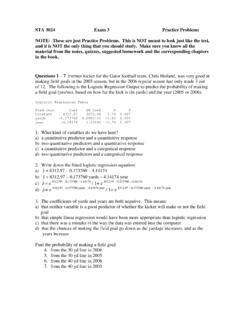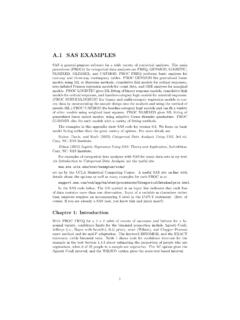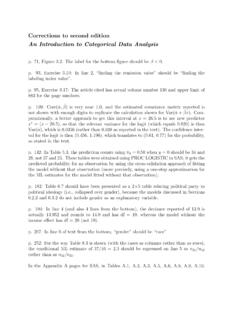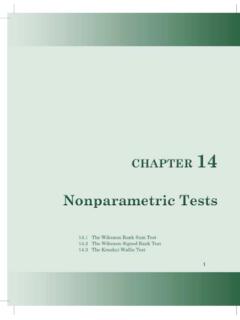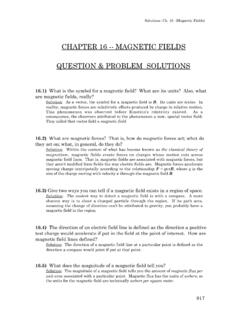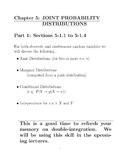Transcription of Chapter 04 - More General Annuities - University of Florida
1 Chapter 04 - more General AnnuitiesSection - Annuities Payable Less Frequently Than conversion periods before each payment4-1n=total number of interest conversion periodsn/k=total number of payments (positive integer)i=rate of interest in each conversion period . General MethodExample: Payments of $500 are made at the end of each year for 10years. Interest has a nominal rate of 8%, convertible quarterly.(a) What is the present value of these future payments?i(4)=.08i(4)/4=.02(1+.02)4= is the annual effective interest rate4-2 Answer=500a10|.08243216= $3, (b) What is the accumulated value of these payments at the end of10 years?Answer=500s10|.08243216= $7, - - - - - - - - -Formula Method for Annuity-ImmediateNow view this setting as n periods with spaced payments.
2 Thepresent value of thesen/kpayments isPVn= k+ 2k+ 3k+ + (n/k)kwhere =11+i= k(1 ( k)(n/k))1 kby SGS4-3 The accumulated value at timet=nis(1+i)nan|isk|i=sn|isk|iBoth of the above formulas are annuity-immediate formulas becausethe payments are at the end of each payment period which iskinterest periods : (previous in this section)i=.02k=4n=40 Accumulated Value=500s40|.02s4|.02= $7, Method for Annuity-due:Present Value:1+ k+ 2k+ 3k+ + n k=(1 ( k)(n/k))1 kby SGSA ccumulated Value at timet=nis:(1+i)nan|iak|i=sn|iak|i= sn|i ak|iBoth of the above formulas are annuity-due formulas because thepayments are at the beginning of each payment period which iskinterest periods :Annuity-immediate with payments less frequent than interestconversionPresent Value=limn (1 n)(1+i)k 1 Annuity-due with payments less frequent than interest conversionPresent Value=limn (1 n)1 k=1i(1 k)/i=1iak|i4-6 Exercise 4-8:The present value of a perpetuity paying 1 at the end of every 3years is12591.
3 - - - - - - - - - -12591=1is3|i=1(1+i)3 1So(1+i)3=91125+1=2161251+i=65i=.204-7 Exercise 4-4:An annuity-immediate that pays $400 quarterly for the next 10 yearscosts $10,000. Calculate the nominal interest rate convertiblemonthly earned by this - - - - - - - - - -4-8 Exercise 4-7:Find an expression for the present value of an annuity-due of $600per annum payable semiannually for 10 years, ifd(12)=.09 .- - - - - - - - - - -4-9 Section - Annuities Payable more Frequently Than of payments in each interest conversion period1/m=amount of each paymentn=total number of interest periods4-10i=effective rate of interest for each conversion period .The annuity-immediate present value at timet=0 for all payments isa(m)n|=1m[ 1m+ 2m+ + mm+ + mnm]=1m[1 n((1+i)1m 1)]=1 ni(m)=ian|ii(m)Herei(m)=m[(1+i)1m 1]because(1+i) =(1+i(m)m) is,i(m)is the nominal period interest rate andiis the effectiveperiod interest rate when each interest period is we know the present value at timet=0, the accumulatedvalue at the end of thenthconversion period ( at timet=mn) iss(m)n|= (1+i)na(m)n|=(1+i)n 1i(m)=isn|ii(m)Example: Payments of $500 are made at the end of each month for10 years.
4 Interest is set at 6% (APR) convertible quarterly. What isthe accumulated value at the last - - - - - - - - - -The effective interest rate per quarter The quarters arethe interest conversion periods. Son=4(10) =40,m=3 andi=.015. Note thatand the accumulated value at the last payment is :(500)(3)s(3)40|=500(3)[(1+.015)40 1].0149256= $81, annuity-due present value at timet=0 for all payments is a(m)n|=1 nd(m)=ian|id(m).The annuity-due accumulated value at the end of thenthconversionperiod ( at timet=mn) is s(m)n|=(1+i)n 1d(m)=isn|id(m)Heredis the effective rate of discount per interest period andd(m)isthe nominal rate of discount per interest period when convertiblemthly in each easily follows that the extension to an annuity-immediateperpetuity produces a present value ofand the extension to an annuity-due perpetuity produces a(m) |=1d(m)Exercise 4-14: Findiwhen3a(2)n|=2a(2)2n|=45s(2)1|.
5 - - - - - - - - - - - - - -These equalities produce4-143(1 n)i(2)=2(1 2n)i(2)=45ii(2)Using the first and third of these terms produces3(1 n) =45iwhich implies n=1 using the first and second terms above yields3(1 n) =2(1 2n).Settingx= nthis becomesTherefore,x= n=12=1 15iwhich implies15i=12ori= - Continuous Payment AnnuitiesConsider amthly annuity-immediate paying a total of 1 annually the payments made in the interval fromttot+ , where0<t<t+ < total of the payments betweentandt+ is 1m=(#ofmthly interval ends between t and t+ )mWhenmis very large, this total payment is approximatelySo whenmis very large, it is (approximately) as though the paymentof 1 made each year is smeared evenly over that year and where thepayment total in any interval is the area under this line above Model:TimePayment0tt+dn014-17 When finding the present value of all payments, we must discountthe payment made at timetby the factor t.
6 Thus the present valueof all payments becomesan|= n01 tdt= tln( ) n0=1ln( )( n 1)and thereforeHere the annual effective interest rateiis fixed and =ln(1+i)isthe force of interest. Note thatlimm a(m)n|=limm 1 ni(m)=1 n =an|because limm i(m)=limm d(m)= . With continuouspayments, the distinction between an annuity-immediate and anannuity-due is moot, that isan|=limm a(m)n|=limm a(m)n|.4-18It likewise follows thatsn|=limm s(m)n|=limm s(m)n|Finally, since =ln(1+i)implies that =e and(1+i) =e , itfollows thatan|=(1 n) =1 e n andsn|=[(1+i)n 1] =en 1 ,where in these expressionsndoes not have to be an 4-18:Ifan|=4 andsn|=12, find .- - - - - - - - - - -4=an|=1 e n impliese n =1 4 12=sn|=en 1 impliesen =12 +1 Putting these two expressions together producesor48 2 8 = yields =848=.
7 16 4-20:Find the value oft, 0<t<1, such that 1 paid at timethas thesame present value as 1 paid continuously between time 0 and - - - - - - - - - -4-21 Section - Payments in Arithmetic ProgressionSuppose an annuity payskat the end of periodkfork=1,2, , 1n1nThe present value of this annuity with arithmetic increasingpayments is(Ia)n|= +2 2+3 3+ + (n 1) n 1+n that(Ia)n| =1+2 +3 2+ +n n 1and thus(Ia)n| (Ia)n|=1+ + 2+ 3+ + n 1 n n= an| n follows that(1 )(Ia)n|=i(Ia)n|= an| n nand thusThe accumulated value at timet=nis:(Is)n|= (1+i)n(Ia)n|= sn| ni=(1+i)sn| a annuity-immediate with General arithmetic progressionpayment amounts:Pat timet=1,P+Qat timet=2,P+2 Qattimet=3, , andP+ (n 1)Qat timet= 1nThe present value att=0 is4-24and the accumulated value att=nis(1+i)n[present value]= (1+i)n[Pan|+Q(an| n ni)]=Psn|+Q(sn| ni)Next examine a decreasing annuity-immediate with a payment ofn+1 kat timet=k, fork=1,2, ,n.
8 This is a special case ofthe previous formula withP=nandQ= present value becomes(Da)n|=nan| (an| n ni)and the accumulated value is(Ds)n|= (1+i)n(Da)n|=nsn| (sn| ni).4-25 For a perpetuity-immediate with General arithmetic progressionpayment amounts, the present value isas long asP>0 andQ>0 becauselimn an|=1iandlimn n n= 4-24: Find the present value of a perpetuity that pays 1 atthe end of the first year, 2 at the end of the second year, increasinguntil a a payment of n at the end of thenthyear and thereafterpayments are level atnper year - - - - - - - - - -(Ia)n|+n ni= 1an| n n+n ni=an| 4-27:An annuity-immediate has semiannual payments of800750700 350withi(2)=.16 . Ifa10|.08= A, find the present value of the annuity interms of - - - - - - - - - - -4-27 Section - Payments in Geometric ProgressionSuppose an annuity-immediate pays(1+k)k 1at the end of periodkfork=1,2, , 1nThe present value of these payments is + (1+k) 2+ (1+k)2 3+ + (1+k)n 1 n4-28= [1 ((1+k) )n1 (1+k) ]=11+i[1 (1+k1+i)n1 (1+k1+i)]The accumulated value att=nis:(1+i)n[present value] = (1+i)n (1+k)n(i k)ifk6=in(1+i)n 1ifk=iWhen dealing with an annuity-due, the present value and theaccumulated value are obtained by multiplying the respectiveexpressions for an annuity-immediate by(1+i).
9 4-29 The present value of a perpetuity with geometrically changingpayments only converges to a finite value whenk<i, in which caseit is(1+ii k)for a : A perpetuity-due pays $1000 for the first year andpayments increase by 3% for each subsequent year until the 20thpayment. After that the payments are the same as the 20th. Find thepresent value if the effective annual interest rate is 5%.- - - - - - - - - - -1000(1+.05)[1 ( ) .03]+1000( )19( )19(.05)=16, +13, $30, 4-32:An employee age 40 earns $40,000 per year and expects to receive3% annual raises at the end of each year for the next 25 years. Theemployee contributes 4% of annual salary at the beginning of eachyear for the next 25 years into a retirement plan. How much will beavailable for retirement at age 65 if the fund earns a 5% effectiveannual rate of interest?
10 - - - - - - - - - - -4-31 Section - Varying Blocks of Equal PaymentsSuppose each period consists of m equal sub-periods and for thesub-periods within a given period the payments are equal. But thepayment amount changes from period to period either in arithmeticor geometric A:During the first period each sub-period payment isk1, during thesecond period each sub-period payment isk2, , and during thenthperiod each sub-period payment find the present value of these payments, we first accumulate thepayments within each period to the end of their period using theapplicable for eachsub-period. This produces an accumulation ofat the end ofthejthperiod forj=1,2, , present value is obtained by including the common factorsm|i and using either the methods of section , if thekm s vary inarithmetic progression, or the methods of section , if thekm s varyin geometric progression.

